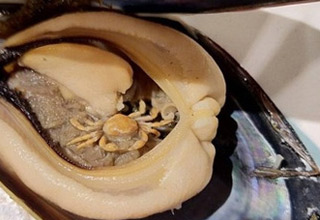NIGHTSHADE ON THE PASSAIC
If someone were to hold a beauty pageant and call it "Miss Passaic River" what would the final contestant look like?
If it were Miss Colorado River she might be a busty blonde, with long smooth legs in a skimpy bikini. If it were Miss Delaware River she would be a gorgeous redhead, giving speeches about joining the 4-H Club. Miss Amazon River would be the most beautiful of all; green eyes, flowing black hair and a crown of orchids across her brow.
Miss Passaic River would be a disgusting, nightmare of a woman. Envision an animated corpse draped in a gown of sewage. She would appear on stage as a shriveled hag, dripping with dioxin. Imagine the sickliest; most putrid woman you have ever known and she would take the prize.
The Passaic River is disgusting. Her 90 miles of twisted shoreline serve as a garbage dump for millions of human consumers. We pump our sewage and throw our trash into the same river that flows back into our homes as drinking water. We shower in a watered down version of our own excrement; filtered, but tainted just the same.
She has been left for dead, raped by her keepers and deserted, but is there no beauty left on the Passaic? She has been trampled, trashed and abandoned, but does that mean she is ugly? Portrait painters have shown us that beauty can be found in even the lowest of women. Photographers will tell you that pictures of corpses tend to take on a life of their own. Is it possible to find secret beauty intact on the Passaic?
These are the thoughts I was pondering as Mr. D and I strapped the canoe to my car. Spring was still a week away and the ice had barely melted. It was an unseasonably warm day, but even though we were wearing t-shirts, the water remained deathly cold. We had to be very careful not to fall in the river. I had been accumulating gear, learning survival techniques and planning all winter for this expedition. In the summer of 2006 I had explored most of the upper Passaic, paddling the Nightshade from West Paterson all the way to Basking Ridge. It took many separate trips to cover this distance and over the winter break, I itched to buy an outboard motor to extend my range.
The snow was still falling when I purchased the engine. Craig’s List was good to me and I found a deal on a beautifully ancient, 3-horsepower Tecumseh outboard. I put a little work into her, installed a mount on the Nightshade, and now we were on our way. It was the first warm day in months and I could feel the excitement rising. I had been looking forward to this for a long time.
One of my favorite launching spots on the Passaic is the Essex County Environmental Center in Roseland. I went to summer camp there as a kid, and it was the first place I had ever set foot in a canoe. The motor’s maiden voyage would be from the same riverbank where I had first canoed, more than 20 years before. Now, in my 30th year I was returning full circle to the Passaic of my childhood, except this time I had 3 horses to push upstream instead of 2 paddles.
Mr. D, helped me load the Nightshade with survival gear: Extra clothes, towels, fire making supplies, Bondo for patching the boat, knives, hatchet, first aid kit; everything wrapped tight in it’s own waterproof Ziploc. I lashed the extra gasoline to the gunwales, tightened the motor clamps and off we shoved into the shimmering brown water. Mr. D paddled out and pointed us upstream, while I choked the motor and opened the fuel line. One pull and she started, blowing blue smoke and gurgling on her way. I opened her up and we were cruising, smiles on our faces. I was back on the hunt. Searching for the elusive beauty of the secret Passaic.
The river was swollen with melting snow, but the motor propelled the Nightshade upstream like a tireless otter. We breezed by the buzzing power plant, under the sagging train trestle, beneath the Rt. 10 Bridge and beyond. Passing the Fernwood Golf Course, we spotted a congregation of golfers taking advantage of the unseasonably warm weather.
They were putting on a green right next to the river and the 2-stroke knock of my engine interrupted their game. I yelled up to Mr. D in the bow, “Lets give ‘em the finger!” Mr. D turned around and smiled, but elected not to join me in flipping off the golfers. It’s not in his nature to be disrespectful so I didn’t hold it against him. I however used both hands, middle finger’s skyward, and Mr. D at least joined me in a laugh at their expense.
The next day wasn’t as warm, but I was impatient, and couldn’t wait to get back on the river. This time I brought two gallons of gas and set out on a riskier mission. Mr. D had the day off, so accompanied me again in the canoe. We launched at the sewage treatment plant in Little Falls braving the mighty torrent of cold current, coursing toward the waterfall.
A mile above the falls, the Pompton River pours into the Passaic, almost doubling her girth. During the wet season, this stretch is one of the most turbulent and dangerous sections of the upper river. In high seas, the current runs fast and deep, pulling everything towards the cliffs.
In the summer of 2006, I braved these waters alone in the Nightshade with only a paddle and my experience to propel me. To my surprise, it took me less than 3 minutes to float downstream, within sight of the raging falls. I wasn’t used to moving this fast on the Passaic and I felt like I might be in trouble. Once past the island, I crossed the river, all the while being swept downstream. When the Nightshade finally touched shore, just above the Mill, I had to stop and catch my breath. Paddling across the current had taken me way too close to the dam. It felt like the river was trying to eat me.
Simple geology and the hand of man are to blame for the tremendous current in Little Falls. Just upstream from the dam, the river bends in a heavy arc, which pushes all the water against the far shore. Conversely, the water is also rushing along the inside bank, because gravity always seeks the easiest path. The falls add to the speed of the current, sucking water downriver like an engine drinking gasoline.
This scenario does not make for pleasurable canoeing, but I knew if I hugged the shore, I could probably make it back. Luckily the bank was lined with suburban homes. If worse came to worse, I could always pull the Nightshade onto someone’s yard and walk back to the car. I didn’t want to abandon ship just yet though, so I hunkered down and grabbed a paddle.
For two hours I fought the current, paddling at full bore. Finally, with aching shoulders and a sore butt, I made it upstream to the landing spot. The Passaic did everything in her power to wash me back, but I stuck to her shore and she was forced to let me pass. I made it home that day, but others have not been so lucky.
One week later, I did my daily Google search for Passaic River news. I was greeted with this headline: N.J. Man Lost In River. I scanned the article and sure enough, it was the same spot above the Mill in Little Falls. 27 year-old Joseph Rivera, his brother and two friends, were hanging out late, drinking some beers when they decided to canoe out to the island. It seemed like a good idea, something fun to do, but shortly after launching, they realized they were in deep trouble.
While attempting to turn back, they somehow lost their paddles in the rough sea. All four of them desperately used their hands to steer the canoe, but the makeshift rowing upset the boat, dumping them in the water. Three guys made it back to shore. Joseph Rivera did not. State and local police used boats, jet skies and helicopters to try and find the body. During the search, one of the police boats was smashed against rocks by the mighty current and two of the officers had to be saved themselves.
Two weeks later, Joseph Rivera’s body was finally found in an intake filter at the top of the Great Falls in Paterson. The family identified him and the paper announced arrangements for his funeral. I had been following the story very closely and I decided to attend the services. Not only was I familiar with the power of this particular spot in the river, I had been on it just days before he died. It was easy for me to picture the cold, black horror of those waters at night. In my imagination, I relived Joseph Rivera’s death as if it were my own.
I felt kind of weird, attending the funeral of a person I didn’t know, but I was strangely compelled not to miss it. I wanted to witness the result of the river’s power. I needed to see the reality behind the articles I had been reading. I thought I could get a glimpse of what my own funeral might be like, but it didn’t go as expected. The wake was very, very sad and my heart went out to his family for the suffering they were enduring. I had always scoffed at life vests, but after attending the funeral, I put personal flotation at the top of my priority list.
Now, on an afternoon in March, life jackets and survival gear in tow, I was returning to the same spot and the water was running high. Even with a motor, I had learned my lesson about venturing past the island in Little Falls. The illusion of power the motor provides is short lived when you suddenly find yourself confronted with mechanical failure. You don’t want to be too close to those falls when the sheer pin snaps and your propeller won’t turn.
Not to say that if you go over the falls you will definitely die, or lose your boat. Properly outfitted with flotation devices, an experienced swimmer could easily make it to shore. But it wasn’t the falls that killed Joseph Rivera. The official cause of death from the coroner’s office was Hypothermia. It was early November when the river took him, and at the time, the water was much warmer than my early March voyage. The risk of hypothermia is real for anyone who falls into cold water and the trick is to be ready for anything. The extra clothes and survival gear weigh down the canoe, but the boy scouts were right when they advised to “always be prepared."
Besides, the motor made short work of the extra weight, as Mr. D and I bullied our way against the current. The weather was in the high 40’s, which is a bit uncomfortable for humans, but the perfect temperature for running an air-cooled outboard. Rough water and wind slapped against the hull of the Nightshade, but she made good progress upstream. While chugging under the Pompton Avenue Bridge, the sound of the reverberating outboard upset a flock of pigeons. We ducked our heads, narrowly missing an aerial bombardment of flying rat droppings.
The sound of the motor attracted a more welcome form of attention when we passed Hooters. Three waitresses on their smoke break waved to us and Mr. D turned around with a thumbs up and a smile. It was smooth sailing ahead until we reached the bend in the river. Suddenly we were confronted with a current so powerful, that Mr. D and I were forced to grab our respective paddles and dig in alongside the motor.
Once past the bend, the water became manageable again and we put our paddles away. I steered us into the quiet water along the shore, sailed underneath Rt. 46 and then Rt. 280, marveling at the sturdiness of the aging concrete. As Two Bridges Road came into sight, the current churned in the wind, but we pushed on in the shallows. Finally, with great relief, we made it past the Pompton River junction and emerged onto a more placid section of the Passaic… The Great Piece Meadows.






1 Comments